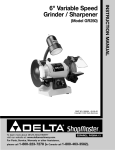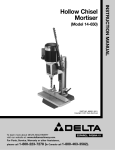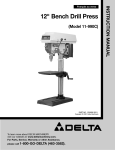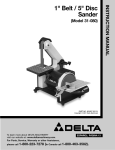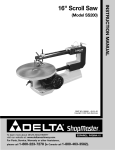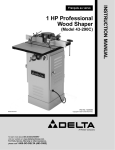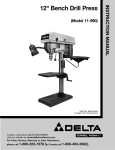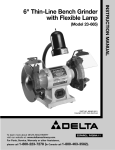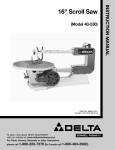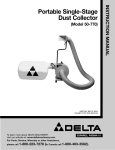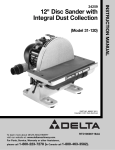Download Delta 50-775 Instruction manual
Transcript
(Model 50-775) PART NO. 902116 (015) Copyright © 2001 Delta Machinery To learn more about DELTA MACHINERY visit our website at: www.deltamachinery.com. For Parts, Service, Warranty or other Assistance, please call SPANISH: PAGE 13 1-800-223-7278 (In Canada call 1-800-463-3582). INSTRUCTION MANUAL One H.P. Single-Stage Dust Collector GENERAL SAFETY RULES Woodworking can be dangerous if safe and proper operating procedures are not followed. As with all machinery, there are certain hazards involved with the operation of the product. Using the machine with respect and caution will considerably lessen the possibility of personal injury. However, if normal safety precautions are overlooked or ignored, personal injury to the operator may result. Safety equipment such as guards, push sticks, hold-downs, featherboards, goggles, dust masks and hearing protection can reduce your potential for injury. But even the best guard won’t make up for poor judgment, carelessness or inattention. Always use common sense and exercise caution in the workshop. If a procedure feels dangerous, don’t try it. Figure out an alternative procedure that feels safer. REMEMBER: Your personal safety is your responsibility. This machine was designed for certain applications only. Delta Machinery strongly recommends that this machine not be modified and/or used for any application other than that for which it was designed. If you have any questions relative to a particular application, DO NOT use the machine until you have first contacted Delta to determine if it can or should be performed on the product. Technical Service Manager Delta Machinery 4825 Highway 45 North Jackson, TN 38305 (IN CANADA: 505 SOUTHGATE DRIVE, GUELPH, ONTARIO N1H 6M7) WARNING: FAILURE TO FOLLOW THESE RULES MAY RESULT IN SERIOUS PERSONAL INJURY 1. FOR YOUR OWN SAFETY, READ INSTRUCTION MANUAL BEFORE OPERATING THE TOOL. Learn the tool’s application and limitations as well as the specific hazards peculiar to it. 2. KEEP GUARDS IN PLACE and in working order. 3. ALWAYS WEAR EYE PROTECTION. Wear safety glasses. Everyday eyeglasses only have impact resistant lenses; they are not safety glasses. Also use face or dust mask if cutting operation is dusty. These safety glasses must conform to ANSI Z87.1 requirements. Note: Approved glasses have Z87 printed or stamped on them. 4. REMOVE ADJUSTING KEYS AND WRENCHES. Form habit of checking to see that keys and adjusting wrenches are removed from tool before turning it “on”. 5. KEEP WORK AREA CLEAN. Cluttered areas and benches invite accidents. 6. DON’T USE IN DANGEROUS ENVIRONMENT. Don’t use power tools in damp or wet locations, or expose them to rain. Keep work area well-lighted. 7. KEEP CHILDREN AND VISITORS AWAY. All children and visitors should be kept a safe distance from work area. 8. MAKE WORKSHOP CHILDPROOF – with padlocks, master switches, or by removing starter keys. 9. DON’T FORCE TOOL. It will do the job better and be safer at the rate for which it was designed. 10. USE RIGHT TOOL. Don’t force tool or attachment to do a job for which it was not designed. 11. WEAR PROPER APPAREL. No loose clothing, gloves, neckties, rings, bracelets, or other jewelry to get caught in moving parts. Nonslip footwear is recommended. Wear protective hair covering to contain long hair. 12. SECURE WORK. Use clamps or a vise to hold work when practical. It’s safer than using your hand and frees both hands to operate tool. 13. DON’T OVERREACH. Keep proper footing and balance at all times. 14. MAINTAIN TOOLS IN TOP CONDITION. Keep tools sharp and clean for best and safest performance. Follow instructions for lubricating and changing accessories. 15. DISCONNECT TOOLS before servicing and when changing accessories such as blades, bits, cutters, etc. 16. USE RECOMMENDED ACCESSORIES. The use of accessories and attachments not recommended by Delta may cause hazards or risk of injury to persons. 17. REDUCE THE RISK OF UNINTENTIONAL STARTING. Make sure switch is in “OFF” position before plugging in power cord. In the event of a power failure, move switch to the “OFF” position. 18. NEVER STAND ON TOOL. Serious injury could occur if the tool is tipped or if the cutting tool is accidentally contacted. 19. CHECK DAMAGED PARTS. Before further use of the tool, a guard or other part that is damaged should be carefully checked to ensure that it will operate properly and perform its intended function – check for alignment of moving parts, binding of moving parts, breakage of parts, mounting, and any other conditions that may affect its operation. A guard or other part that is damaged should be properly repaired or replaced. 20. DIRECTION OF FEED. Feed work into a blade or cutter against the direction of rotation of the blade or cutter only. 21. NEVER LEAVE TOOL RUNNING UNATTENDED. TURN POWER OFF. Don’t leave tool until it comes to a complete stop. 22. STAY ALERT, WATCH WHAT YOU ARE DOING, AND USE COMMON SENSE WHEN OPERATING A POWER TOOL. DO NOT USE TOOL WHILE TIRED OR UNDER THE INFLUENCE OF DRUGS, ALCOHOL, OR MEDICATION. A moment of inattention while operating power tools may result in serious personal injury. 23. MAKE SURE TOOL IS DISCONNECTED FROM P O W E R S U P P LY w h i l e m o t o r i s b e i n g m o u n t e d , connected or reconnected. 24. THE DUST GENERATED by certain woods and wood products can be injurious to your health. Always operate machinery in well ventilated areas and provide for proper dust removal. Use wood dust collection systems whenever possible. 25. WARNING: SOME DUST CREATED BY POWER SANDING, SAWING, GRINDING, DRILLING, AND OTHER CONSTRUCTION ACTIVITIES contains chemicals known to cause cancer, birth defects or other reproductive harm. Some examples of these chemicals are: · lead from lead-based paints, · crystalline silica from bricks and cement and other masonry products, and · arsenic and chromium from chemically-treated lumber. Your risk from these exposures varies, depending on how often you do this type of work. To reduce your exposure to these chemicals: work in a well ventilated area, and work with approved safety equipment, such as those dust masks that are specially designed to filter out microscopic particles. SAVE THESE INSTRUCTIONS. Refer to them often and use them to instruct others. 2 IMPORTANT SAFETY RULES FOR DUST COLLECTORS 10. DO NOT handle the plug or dust collector with wet hands. WARNING: Basic precautions should always be followed when using your dust collector. To reduce the risk of injury, electrical shock or fire, comply with the safety rules listed below: 11. REPLACE a damaged cord immediately. DO NOT use a damaged cord or plug. If the dust collector is not operating properly, or has been damaged, left outdoors or has been in contact with water, take it to an Authorized Service Center for service. 1. DO NOT leave the dust collector plugged into the electrical outlet. Unplug dust collector from the outlet when not in use and before servicing, changing bags, unclogging and cleaning. 12. DO NOT use the dust collector as a toy. DO NOT use near or around children. 2. ALWAYS turn all controls “OFF” before unplugging the dust collector. 13. DO NOT insert fingers or foreign objects into the dust intake port. Keep hair, loose clothing, fingers, and all body parts away from openings and moving parts of the dust collector. 3. WARNING: TO REDUCE THE RISK OF ELECTRICAL SHOCK, do not use on wet surfaces. Do not expose to rain. Store indoors. 14. DO NOT use with any opening blocked; keep free of dust, lint, hair, and anything that may reduce air flow. 4. FOLLOW all electrical and safety codes, including the National Electric Code (NEC) and the Occupational Safety and Health Regulations (OSHA). All electrical connections and wiring should be made by qualified personnel only. 15. NEVER use the dust collector without the dust collection bag in place and properly secured. 16. ALWAYS use intake cover to cover inlet port when the dust collector is not in use or mounted to a supporting surface for storage. 5. DO NOT use the dust collector to pick up flammable or combustible liquids, such as gasoline. NEVER use the dust collector near any flammable or combustible liquids. 17. PERIODICALLY INSPECT dust bag for any cuts, rips or tears. NEVER operate the dust collector with a damaged bag or vacuum hose. 6. DO NOT use the dust collector to pick up metal shavings, metal dust, or metal parts. 18. The dust collector is designed for home use or light commercial duty ONLY! 7. NEVER use the dust collector to dissipate fumes or smoke. NEVER pick up anything that is burning or smoking, such as cigarettes, matches or hot ashes. 19. CONNECT dust collector to a properly grounded outlet only. See grounding instructions. 8. DO NOT pull the dust collector by the power cord. NEVER allow the power cord to come in contact with sharp edges, hot surfaces, oil or grease. Do not place anything over the top of the power cord. 20. USE EXTRA CARE when cleaning on stairs. 9. DO NOT unplug the dust collector by pulling on the power cord. DO NOT place anything over the top of the cord. DO NOT run appliance over the cord. ALWAYS grasp the plug, not the cord. 3 UNPACKING AND CLEANING Carefully unpack the tool and all loose items from the shipping container(s). Remove the protective coating from all unpainted surfaces. This coating may be removed with a soft cloth moistened with kerosene (do not use acetone, gasoline or lacquer thinner for this purpose). After cleaning, cover the unpainted surfaces with a good quality household floor paste wax. 5 6 2 1 10 14 11 13 3 12 15 7 8 4 9 Fig. 2 1. 2. 3. 4. 5. 6. 7. 8. Motor and blower assembly Base Wheel casters (4) Side support (2) Upper bag (bag with loop see Fig. 14) Lower bag Filter bag clamp (2) Firm board 9. 10. 11. 12. 13. 14. 15. 4 Filter bag hanger Hose Hose clamp (2) 5/16 Hex nut (9) 5/16 Lockwasher (12) 5/16-18x3/4" Hex head screw (12) Intake cap ASSEMBLY ASSEMBLING WHEEL CASTERS 1. Remove the hex nut and lockwasher from each of the four wheel casters. 2. Place the dust collector on its side. A 2. Insert bolt from wheel caster through the four holes (A) Fig. 3 in the base of the dust collector (three are not shown). Fig. 3 3. Place a lockwasher (A) Fig. 4 onto each bolt. 4. Thread hex nut (B) Fig. 4 onto each of the four bolts and tighten securely. B A ASSEMBLING SIDE SUPPORTS Fig. 4 1. Place the dust collector base (A) Fig. 5, in an upright position as shown. 2. Align the two holes in the bottom of side support (B) Fig. 5 with the two holes (A) in the base. B 3. Insert a 5/16-18x3/4" hex head screw (A) Fig. 6 thru each hole in the side support and base. A 4. Place a 5/16" lockwasher onto the hex head screw. 5. Thread a 5/16" hex nut onto the hex head screw and tighten securely. Fig. 5 6. Repeat this process for the remaining side support. 7. Fig. 7 shows both side supports (A) attached to the base (B). A A B A Fig. 6 Fig. 7 5 ATTACHING MOTOR AND BLOWER ASSEMBLY TO FRAME B A A 1. Place motor assembly and base assembly on their side. C 2. Align the four holes, two shown at (C), on the top of the side supports (A) Fig. 8, with the four holes in the motor assembly (B). 3. Place a 5/16" lockwasher onto a 5/16-18x3/4" hex head screw and insert the bolt thru the side support and thread bolt into the tapped hole in the motor assembly. Fig. 8 4. Repeat this process for the three remaining holes. 5. Fig. 9 shows the motor and blower assembly attached to the side supports. ASSEMBLING FIRM BOARD 1. Place the firm board (A) inside the two side supports (B) Fig. 10. NOTE: MAKE SURE FIRM BOARD IS ATTACHED TO THE SIDE SUPPORTS CLOSEST TO THE MOTOR. 2. Align the four holes in the firm board with the four holes in the side boards as shown in Fig. 10. Fig. 9 3. Insert a 5/16-18x3/4" hex head screw (A) Fig. 11, thru the side supports and the firm board. 4. Place a 5/16" lockwasher on the hex head screw. 5. Thread a 5/16" hex nut on the hex head screw and tighten securely. 6. Repeat this process for the three remaining holes for attaching the firm board. 7. Fig. 12 shows the firm board attached to the side supports. A B Fig. 10 A Fig. 12 Fig. 11 6 B ASSEMBLING FILTER AND DUST COLLECTION BAGS TO DRUM B 1. Thread a 5/16" hex nut (A) Fig. 13, onto the end of bag support rod (B). Thread rod into hole (E) and tighten nut (A) against motor assembly to hold support rod (B) upright. Height of support rod can be adjusted after the filter bag is in place. The hook in the support rod (B) should be positioned over the drum. A E Fig. 13 B F 2. Hook the loop on the top of filter bag (F) Fig. 14, onto the end of support rod (B). 3. Position open end of filter bag (F) Fig. 15, over the lip of drum (G). NOTE: It may be necessary to adjust the height of the drum support rod at this time. If adjustment is necessary, loosen nut (A) Fig. 13, and rotate support rod (B) as needed to obtain proper rod height to support filter bag (F). Tighten nut (A) Fig. 13. Place locking band (H) around the filter bag (F) and fasten filter bag to drum by locking clamp (J) as shown in Fig. 15. IMPORTANT: Make certain band (H) is positioned in the channel of drum (G) before locking clamp (J). Fig. 14 F H J G Fig. 15 4. Place the remaining locking band (H) Fig. 16, around the dust collection bag (K). Position open end of bag over the lip of drum (G) and fasten with locking clamp (J). NOTE: Make certain locking band (H) is positioned in the channel of drum before locking clamp (J). G H J K Fig. 16 7 ASSEMBLING DUST INTAKE HOSE TO MOTOR AND BLOWER ASSEMBLY E C A The dust collector is supplied with a 4" flexible dust intake hose. Place the intake cap holder (E) on the dust collector as shown in Fig. 17. NOTE: DO NOT COVER THE INTAKE PORT WITH THE INTAKE CAP WHEN ATTACHING THE HOSE TO THE INTAKE PORT. To assemble the dust collection hose to the motor and blower assembly, loosely attach hose clamp (A) Fig. 17, around one end of flexible hose (B) and assemble the hose to dust intake port (C). Tighten hose clamp (A) Fig. 18. Assemble the remaining clamp to the other end of the flexible hose and to the woodworking machine. IMPORTANT: Do not operate the dust collector without the flexible hose assembled to the dust intake port. Fig. 17 D A Always disconnect dust collector from the power source before connecting or disconnecting an air intake hose to or from the blower and motor assembly. B Fig. 18 CONNECTING TOOL TO POWER SOURCE POWER CONNECTIONS A separate electrical circuit should be used for your tools. This circuit should not be less than #12 wire and should be protected with a 20 Amp time lag fuse. If an extension cord is used, use only 3-wire extension cords which have 3prong grounding type plugs and 3-hole receptacles which accept the tool’s plug. Before connecting the motor to the power line, make sure the switch is in the “OFF” position and be sure that the electric current is of the same characteristics as indicated on the tool. All line connections should make good contact. Running on low voltage will damage the motor. MOTOR SPECIFICATIONS Your tool is wired for 120 volt, 60 HZ alternating current. Before connecting the tool to the power source, make sure the switch is in the “OFF” position. GROUNDING INSTRUCTIONS WARNING: THIS TOOL MUST BE GROUNDED WHILE IN USE TO PROTECT THE OPERATOR FROM ELECTRIC SHOCK. This tool must be grounded. If it should malfunction or break down, grounding provides a path of least resistance for electric current to reduce the risk of electric shock. This tool is equipped with a cord having an equipment-grounding conductor and grounding plug. The plug must be inserted into an appropriate outlet that is properly installed and grounded in accordance with all local codes and ordinances. WARNING: Improper connection of the equipment-grounding conductor can result in a risk of electric shock. Check with a qualified electrician or service person if you are in doubt as to whether the outlet is properly grounded. Do not modify the plug provided with the dust collector. If it will not fit the outlet, have a proper outlet installed by a qualified electrician. 8 120 VOLT, SINGLE PHASE OPERATION GROUNDED OUTLET BOX This tool must be grounded while in use to protect the operator from electric shock. The motor recommended for use with your dust collector is shipped wired for 120 Volt, Single Phase, and is equipped with an approved 3-conductor cord and 3-prong grounding type plug to fit the proper grounding type receptacle, as shown in Fig. 19. The green conductor in the cord is the grounding wire. Never connect the green wire to a live terminal. CURRENT CARRYING PRONGS GROUNDING BLADE IS LONGEST OF THE 3 BLADES A temporary adapter, shown in Fig. 20, is available for connecting 3-prong grounding type plugs to 2-prong receptacles if a properly grounded outlet is not available. The temporary adapter should be used only until a properly grounded outlet can be installed by a qualified electrician. THIS ADAPTER IS NOT APPLICABLE IN CANADA. The green-colored rigid ear, lug, etc., extending from the adapter, is the grounding means and must be connected to a permanent ground such as to a properly grounded outlet box, as shown in Fig. 20. Whenever the adapter is used, it must be held in place with a metal screw. Fig. 19 GROUNDED OUTLET BOX GROUNDING MEANS ADAPTER 240 VOLT, SINGLE PHASE OPERATION Fig. 20 The motor supplied with your tool is a dual voltage 120/240 volt motor. The dust collector motor is shipped ready-to-run for 120 volt operation; however, it may be converted for 240 volt operation. GROUNDED OUTLET BOX CURRENT CARRYING PRONGS The conversion of your dust collector for 240 volt operation must be done by qualified electrical personnel. Should you desire to have your dust collector converted for 240 volts, take your dust collector to your local Authorized Delta Service Center. Call 1-800-223-7278 for the location of the nearest Authorized Service Center. The Service Center will be able to convert your dust collector for 240 volts by (a) re-wiring the motor for 240 volts; (b) installing a 240 volt attachment plug to the power supply cord; and (c) replacing the single pole on/off switch shipped with your dust collector with a double pole switch. 240 VOLT GROUND PRONG Fig. 21 AS A PRECAUTION IN ALL CASES, MAKE CERTAIN THE RECEPTACLE IN QUESTION IS PROPERLY GROUNDED. IF YOU ARE NOT SURE, HAVE A QUALIFIED ELECTRICIAN CHECK THE RECEPTACLE. The dust collector with a 240 volt plug should only be connected to an outlet having the same configuration as the plug illustrated in Fig. 21. No adapter is available or should be used with the 240 volt plug. 9 EXTENSION CORDS Use proper extension cords. Make sure your extension cord is in good condition and is a 3-wire extension cord which has a 3-prong grounding type plug and a 3-hole receptacle which will accept the tool’s plug. When using an extension cord, be sure to use one heavy enough to carry the current of the tool. An undersized cord will cause a drop in line voltage, resulting in loss of power and overheating. Fig. 22 & 23, shows the correct gauge to use depending on the cord length. If in doubt, use the next heavier gauge. The smaller the gauge number, the heavier the cord. MINIMUM GAUGE EXTENSION CORD MINIMUM GAUGE EXTENSION CORD RECOMMENDED SIZES FOR USE WITH STATIONARY ELECTRIC TOOLS RECOMMENDED SIZES FOR USE WITH STATIONARY ELECTRIC TOOLS Ampere Rating 0-6 0-6 0-6 0-6 6-10 6-10 6-10 6-10 10-12 10-12 10-12 10-12 12-16 12-16 12-16 Volts 120 120 120 120 120 120 120 120 120 120 120 120 120 120 120 Total Length of Cord in Feet up to 25 25-50 50-100 100-150 up to 25 25-50 50-100 100-150 up to 25 25-50 50-100 100-150 up to 25 25-50 Gauge of Extension Cord 18 AWG 16 AWG 16 AWG 14 AWG 18 AWG 16 AWG 14 AWG 12 AWG 16 AWG 16 AWG 14 AWG 12 AWG 14 AWG 12 AWG Ampere Rating 0-6 0-6 0-6 0-6 6-10 6-10 6-10 6-10 10-12 10-12 10-12 10-12 12-16 12-16 12-16 GREATER THAN 50 FEET NOT RECOMMENDED Volts 240 240 240 240 240 240 240 240 240 240 240 240 240 240 240 Total Length of Cord in Feet up to 50 50-100 100-200 200-300 up to 50 50-100 100-200 200-300 up to 50 50-100 100-200 200-300 up to 50 50-100 Gauge of Extension Cord 18 AWG 16 AWG 16 AWG 14 AWG 18 AWG 16 AWG 14 AWG 12 AWG 16 AWG 16 AWG 14 AWG 12 AWG 14 AWG 12 AWG GREATER THAN 100 FEET NOT RECOMMENDED Fig. 23 Fig. 22 OPERATING CONTROLS FOR OPERATOR SAFETY, BEFORE OPERATING THE MACHINE, MAKE CERTAIN THAT THE DUST INTAKE HOSE IS ALWAYS ATTACHED TO THE DUST INTAKE PORT. THE ROTATING FAN LOCATED INSIDE THE BLOWER HOUSING IS ACCESSIBLE THROUGH THE DUST IN-TAKE PORT AND CAN BE HAZARDOUS. ALWAYS WEAR PROPER APPAREL. DO NOT WEAR JEWELRY AND KEEP FINGERS AND ALL FOREIGN OBJECTS OUT OF THE DUST INTAKE PORT. FOLLOW THE SAFETY RULES EARLIER IN THIS MANUAL. ON/OFF SWITCH The on/off switch is located on the side of the motor. To turn the dust collector “ON,” push switch toggle (A) Fig. 24, toward the “ON” mark. To turn the dust collector “OFF,” push switch toggle (A) toward the “OFF” mark. A LOCKING SWITCH IN THE “OFF” POSITION Fig. 24 When the tool is not in use, the switch should be locked in the “OFF” position to prevent unauthorized use. This can be done by grasping the switch toggle (A) Fig. 25, and pulling it out of the switch (B) as shown. With the switch toggle (A) Fig. 25, removed, the switch will not operate. However, should the switch toggle (A) be removed while the dust collector is running, it can be turned “OFF” once, but cannot be restarted without inserting the switch toggle. A B 10 Fig. 25 MAINTENANCE NOTE: Before any maintenance or service is performed, be sure the unit is disconnected from the power source to prevent accidental starting. All servicing other than the items recommended in this Instruction Manual should be performed by an authorized service facility. When storing your dust collector, remove power supply cord from the electrical outlet. Coil the cord neatly and place it off the floor on the base of the dust collector to eliminate potential cord damage. MOTOR MAINTENANCE Removing dust and dirt: Blow off motor with low pressure air to remove dust or dirt. Air pressure above 50 P.S.I. should not be used as high pressure may damage insulation and blow dirt under loosened tape. The operator performing this cleaning function should always wear eye protective goggles. Dust can cause excessive insulation temperatures. ACCESSORIES A complete line of accessories is available from your Delta Supplier, Porter-Cable · Delta Factory Service Centers, and Delta Authorized Service Stations. Please visit our Web Site www.deltamachinery.com for a catalog or for the name of your nearest supplier. WARNING: Since accessories, other than those offered by Delta, have not been tested with this product, use of such accessories could be hazardous. For safest operation, only Delta recommended accessories should be used with this product. PARTS, SERVICE OR WARRANTY ASSISTANCE All Delta Machines and accessories are manufactured to high quality standards and are serviced by a network of PorterCable · Delta Factory Service Centers and Delta Authorized Service Stations. To obtain additional information regarding your Delta quality product or to obtain parts, service, warranty assistance, or the location of the nearest service outlet, please call 1-800-223-7278 (In Canada call 1-800-463-3582). Two Year Limited Warranty Delta will repair or replace, at its expense and at its option, any Delta machine, machine part, or machine accessory which in normal use has proven to be defective in workmanship or material, provided that the customer returns the product prepaid to a Delta factory service center or authorized service station with proof of purchase of the product within two years and provides Delta with reasonable opportunity to verify the alleged defect by inspection. Delta may require that electric motors be returned prepaid to a motor manufacturer’s authorized station for inspection and repair or replacement. Delta will not be responsible for any asserted defect which has resulted from normal wear, misuse, abuse or repair or alteration made or specifically authorized by anyone other than an authorized Delta service facility or representative. Under no circumstances will Delta be liable for incidental or consequential damages resulting from defective products. This warranty is Delta’s sole warranty and sets forth the customer’s exclusive remedy, with respect to defective products; all other warranties, express or implied, whether of merchantability, fitness for purpose, or otherwise, are expressly disclaimed by Delta. Printed in U.S.A. 11 NOTES 12












